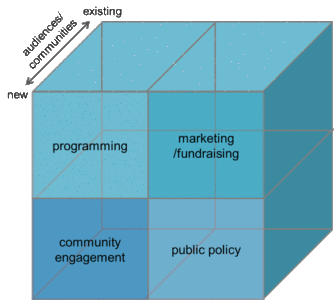by Amelia Northrup-Simpson
This post is part of a series in conjunction with TRG Arts on developing relationships with both new communities and existing stakeholders through artistic programming, marketing and fundraising, community engagement, and public policy. (Cross-post can be found at Analysis from TRG Arts.)
Do you treat arts patrons like customers, clients, or collaborators?
In the first post in this series, Doug Borwick laid out this important question. Let’s re-cap the definitions of each:
- The exchange with a customer is largely arms-length. We provide something, they buy it. End of story.
- With a client there is a relationship, but they still come to us for the “product” we create and are selling. We may tailor it to their particular interests but we are in charge of the “supply.”
- A collaborator is a partner, suggesting mutual benefit and participation.
If our job as arts managers is to bring artists and audiences together, these definitions become very important. The spectrum from customer to collaborator indicates how deeply we allow the connection to artists to go.
It also brings up the polarity between new and existing audiences. How do we include new audiences and welcome them in as collaborators? How do we deepen relationships with existing stakeholders and move them beyond “customer” status? Is it possible to do either with our current business model? If it is possible, how do we balance the wants and needs of new and existing constituencies?
This polarity and the ways we can engage new and existing audiences has inspired this blog series, which is designed around the following questions:
How does the need to deepen relationships with current stakeholders and build relationships with new audiences and new communities affect your work in the arts? What future changes in your work might be necessary/helpful due to that need?
TRG is looking forward to promoting new voices on this blog, including our own clients and TRG Council members, as well as other movers and shakers in the field.
Among these different voices, there’s not one “right” way to address the new vs. existing polarity. We discussed the ways that organizations tackle this issue and identified 4 categories of initiatives:
- programming
- marketing/fundraising
- community engagement
- public policy
Each post in this series addresses one or more of these categories. Underlying each category is the tension between new and existing. There are things that we do in each area that serve new communities, existing patrons, or both. I’ve visualized it in the diagram below, which serves as a sort of roadmap for the series:

———————————————————-
 Amelia Northrup-Simpson has devoted her career to bringing audiences and artists together. As frequent writer and speaker on building sustainable arts organizations, developing and engaging arts audiences, and patron technology expectations, she helps arts managers cut through noise and distractions to focus on the most effective marketing and technology strategies for their organization.
Amelia Northrup-Simpson has devoted her career to bringing audiences and artists together. As frequent writer and speaker on building sustainable arts organizations, developing and engaging arts audiences, and patron technology expectations, she helps arts managers cut through noise and distractions to focus on the most effective marketing and technology strategies for their organization.
Currently, Amelia is the Director of Strategic Communications at TRG Arts, a consulting firm which focuses on getting audience development and revenue results from loyalty, pricing, and data strategies. She serves as an editor and writer for the firm’s consulting and research analytics projects, presentations and webinars, case studies, and the TRG blog Analysis from TRG Arts. She also serves as TRG’s in-house marketing technologist and user interface advisor. She has presented conference panels, workshops, and webinars for Americans for the Arts, Theatre Communications Group, Do Good Data, Chorus America, and Colorado Creative Industries, among others. She is a member of the artsmarketing.org Advisory Committee and serves as adjunct faculty at University of Denver’s Arts Development and Program Management master’s degree program.

[…] serious listeners at the Manhattan … read more AJBlog: Jazz Beyond Jazz Published 2016-04-19 Client, Customer, Collaborator: A Roadmap Do you treat arts patrons like customers, clients, or collaborators? … If our job as arts […]
[WORDPRESS HASHCASH] The comment’s server IP (66.33.193.103) doesn’t match the comment’s URL host IP (66.33.193.74) and so is spam.